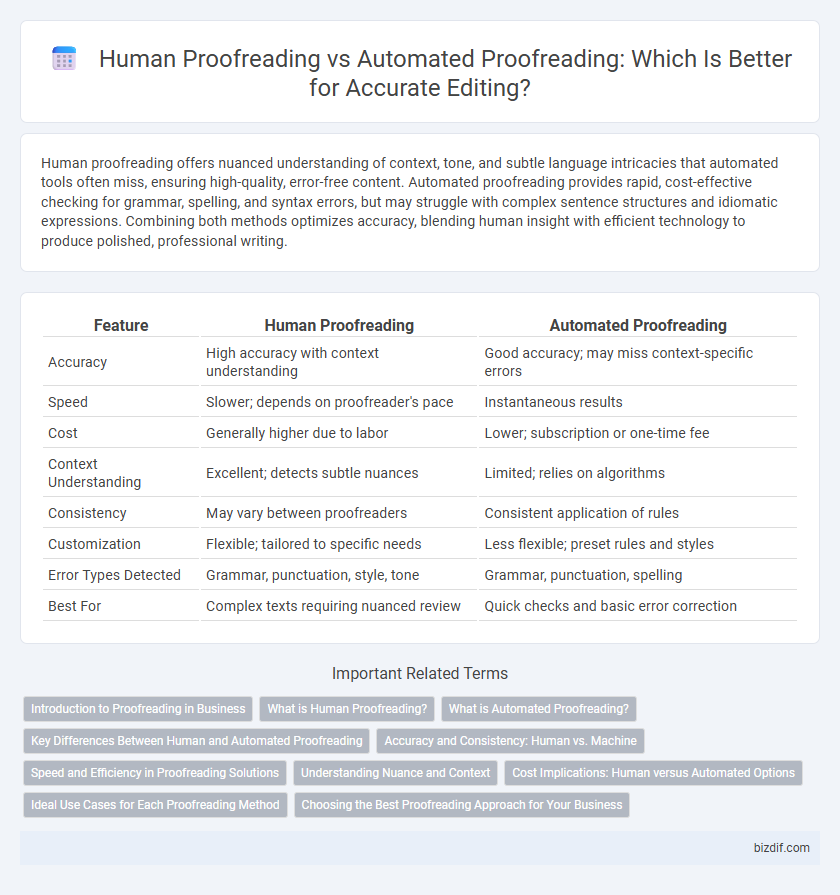Human proofreading offers nuanced understanding of context, tone, and subtle language intricacies that automated tools often miss, ensuring high-quality, error-free content. Automated proofreading provides rapid, cost-effective checking for grammar, spelling, and syntax errors, but may struggle with complex sentence structures and idiomatic expressions. Combining both methods optimizes accuracy, blending human insight with efficient technology to produce polished, professional writing.
Table of Comparison
| Feature | Human Proofreading | Automated Proofreading |
|---|---|---|
| Accuracy | High accuracy with context understanding | Good accuracy; may miss context-specific errors |
| Speed | Slower; depends on proofreader's pace | Instantaneous results |
| Cost | Generally higher due to labor | Lower; subscription or one-time fee |
| Context Understanding | Excellent; detects subtle nuances | Limited; relies on algorithms |
| Consistency | May vary between proofreaders | Consistent application of rules |
| Customization | Flexible; tailored to specific needs | Less flexible; preset rules and styles |
| Error Types Detected | Grammar, punctuation, style, tone | Grammar, punctuation, spelling |
| Best For | Complex texts requiring nuanced review | Quick checks and basic error correction |
Introduction to Proofreading in Business
Human proofreading in business ensures nuanced understanding of context, tone, and industry-specific terminology, providing tailored and accurate error correction. Automated proofreading tools offer rapid, cost-effective solutions by detecting common grammatical and typographical errors through algorithms and AI technology. Combining both methods enhances document quality, balancing efficiency with in-depth linguistic insight for professional communication.
What is Human Proofreading?
Human proofreading involves a careful review of text by a skilled editor who identifies and corrects grammar, spelling, punctuation, and contextual errors that automated tools may miss. This method ensures nuanced understanding of tone, style, and meaning tailored to the target audience. Human proofreaders excel in detecting inconsistencies and cultural references, providing a sophisticated level of accuracy beyond algorithmic capabilities.
What is Automated Proofreading?
Automated proofreading utilizes advanced algorithms and natural language processing to analyze text for grammar, spelling, punctuation, and style errors with high efficiency. It offers real-time suggestions and can process large volumes of content quickly, making it ideal for initial drafts and bulk editing. However, automated tools may miss nuanced context and complex language subtleties that human proofreaders can effectively identify and correct.
Key Differences Between Human and Automated Proofreading
Human proofreading excels in detecting nuanced language errors, tone inconsistencies, and contextual mistakes that automated tools often miss. Automated proofreading offers speed and consistency by quickly identifying grammar, spelling, and punctuation errors but struggles with complex sentence structures and idiomatic expressions. The key differences lie in human cognitive understanding versus algorithmic pattern recognition, making a combined approach ideal for comprehensive text accuracy.
Accuracy and Consistency: Human vs. Machine
Human proofreading offers nuanced understanding of context, tone, and complex language subtleties, providing higher accuracy in identifying errors related to semantics and stylistic choices. Automated proofreading excels in consistency by systematically applying grammar and spelling rules across large volumes of text without fatigue or oversight. Combining both methods leverages human discernment and machine precision, ensuring comprehensive error detection and overall text quality.
Speed and Efficiency in Proofreading Solutions
Human proofreading offers nuanced understanding of context, tone, and complex language subtleties, which automated tools often miss, but it requires significantly more time and labor. Automated proofreading tools deliver rapid scanning and correction of grammar, spelling, and punctuation errors across large documents, enhancing overall efficiency in bulk processing. Combining human insight with automated systems optimizes speed and accuracy, providing comprehensive proofreading solutions.
Understanding Nuance and Context
Human proofreading excels in understanding nuance and context, capturing subtleties such as tone, idiomatic expressions, and cultural references that automated tools often miss. Automated proofreading relies on algorithms and databases to identify grammatical errors and inconsistencies but struggles with complex linguistic elements and implied meanings. Incorporating human insight ensures more accurate and context-aware revisions, especially in creative, technical, or highly specialized texts.
Cost Implications: Human versus Automated Options
Human proofreading typically incurs higher costs due to professional expertise and time invested, while automated proofreading tools offer more affordable solutions with faster turnaround times. However, automated tools may miss nuanced errors and context-specific issues that human proofreaders can catch, potentially affecting overall quality and increasing indirect costs. Balancing cost with accuracy often leads businesses to combine both methods for optimized proofreading efficiency.
Ideal Use Cases for Each Proofreading Method
Human proofreading excels in nuanced contexts such as literary works, academic papers, and marketing content where understanding tone, style, and context is critical. Automated proofreading tools are ideal for quick checks of grammar, spelling, and punctuation in emails, website content, and technical documents requiring fast turnaround. Combining both methods optimizes accuracy and efficiency, particularly in professional publishing and corporate communication.
Choosing the Best Proofreading Approach for Your Business
Choosing the best proofreading approach for your business hinges on the balance between accuracy, speed, and cost-effectiveness. Human proofreading excels in capturing nuanced language, context, and complex errors, making it ideal for high-stakes documents and creative content. Automated proofreading tools offer rapid, scalable solutions with consistent grammar checks but may overlook subtle mistakes, necessitating a hybrid approach for optimal results.
Human Proofreading vs Automated Proofreading Infographic

 bizdif.com
bizdif.com